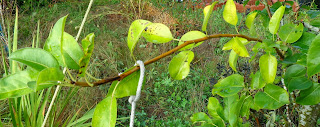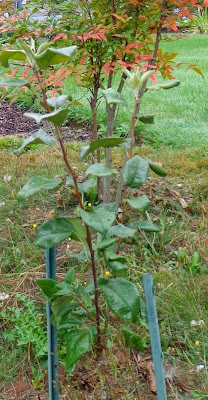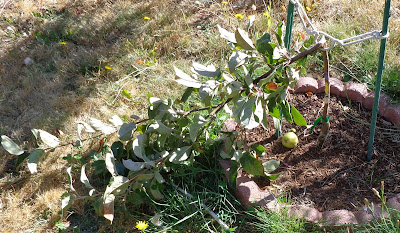 |
| Pear Graft #1 |
All of the pear grafts and apple grafts took and grew this year.
I did not keep track of varieties. The pear grafts were on the 2 Asian pear trees. The intent is to have pollinating varieties, on the same tree. And novelty.
The pollinating varieties were, two from a multigraft Asian pear in the Vancouver yard, plus 2 prunings from newly planted pear trees. Those were European pears, Rescue and Orca.
 |
| Pear Graft #2 |
 |
| Pear Graft #3 |
Some of the grafts grew very fast. Others barely grew.
I grafted the apples on Feb 23rd at the Home Orchard Society grafting class.
Spitzenberg and Suttons Beauty. Each has 2 strong growths. Late winter, I want to graft each with an additional variety. Or with 2 additional varieties, allowing a bud to form a branch below the graft for the originals. These would be very low branching trees, which is what I want. I want to get them planted in-ground this fall, so the roots have a chance to grow. That means I will need deer protection, too, which is more of a chore. Not too difficult.
The regenerated Honeycrisp broke off near the ground, but above the graft, last year. I debated re-grafting it. Instead, I pruned short, and allowed the tree to grow from below the cut. It has 2 strong growths. Again, I would like to graft an additional variety onto one or both of the growths.
In the Vancouver yard, I have the Honeycrisp start, Jonagold, Liberty, and Karmijn de Sonneville. At Battleground, there are the columnar varieties Golden Sentinel and Red Sentinel. GS had one apple this year. It's only about 2 feet tall. That's enough varieties for my test garden.
There is also Prairie Fire crabapple, now, which I hope serves as a pollinator.
 |
| Pear Graft #4 |
 |
| Regenerated Honeycrisp Apple |
 |
| New Dwarf Apple Grafts |
 |
| Broken Honeycrisp tree Sept 2012 |













 This is Buddleia globosa, pic via
This is Buddleia globosa, pic via 

